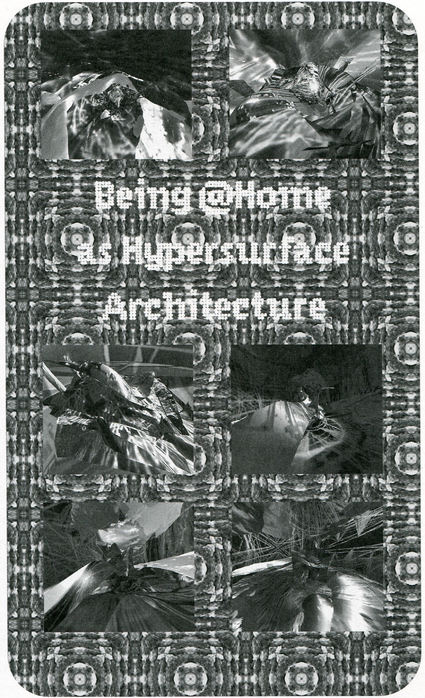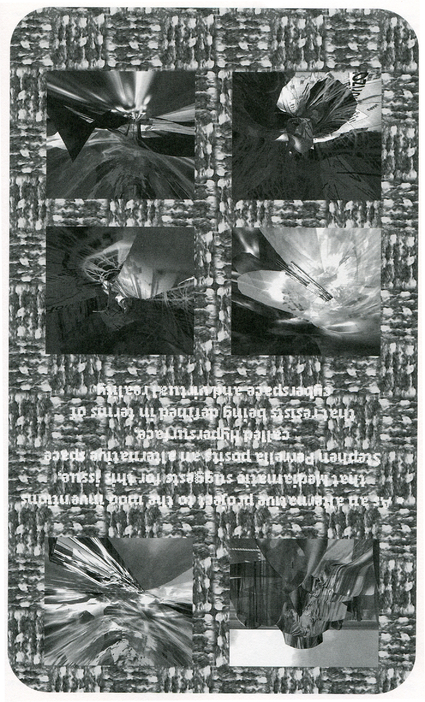One finds typically that static categorical ideas relevant in a material embodied world are re-realized in cyberspace. This extension of Western Cartesian assumptions into cyberspace presupposes a dichotomy between mind and body, whereby the mind is reconstituted as a technological inside. Cyberspace serves as a technological reflection or extension of the ego cogito, or the self as mind. Cyberspace does not exist other than as a linguistic/conceptual construct that reiterates Cartesian space, a computer platform epistemology, re-reconstituting dualities.
Similarly the notion of home is never a final, deduced state. It is a fixed entity only when one assumes a fixed identity; as in the statement this is my home. The question of 'home' and identity in the context of a culture racing toward virtual reality creates a catastrophic dilemma for both notions. The gap between any conception of home (as Christopher Alexander nostalgically dreams of it) and that same humanist conception of home re-realized in cyberspace (as argued for in Michael Benedikt's introduction to his anthology Cyberspace: First Steps) configures a perverse and schizophrenic condition. The dualisms of Cartesian thought are manifested: home, or mind, is assumed to be inside, and simultaneously have a technologically constituted home/mind-self, in cyberspace (as a space other than the categorical real).
An example of this uncanny condition exists when one dons cyberwear, creating a simultaneously real and virtual body, and an event impacting the virtual body effects the corporeal body. This constitutes a schizophrenic moment. An experience that folds into the gap between real and virtual. In other words, what happens when the self we see in the mirror is taken as the real? To posit an alternative to the dualistic assumptions of cyberspace, the phenomenal dimensions of polarities may be considered as always already interspersed through each other, neither existing as a pure state. Toward this Cartesian techno-abyss, I posit an alternative spatiality called Hypersurface. Hypersurface is an alternative to the schizo-dualistic oxymoron 'virtual reality.'
To engage the architecture of hypersurface, one must reveal the site of the most concentrated focus of attention and desire of Western culture: the 'screen', must be rethought of as a sponge rather than as a knife dividing the real/virtual. All the dualism in Cartesian culture; inside/outside, male/female, ground/edifice, ornament/structure, form/function, etc., are constituted by the separatrix (/) that now may technologically be understood as a 'screen.' The term screen here is meant both literally and phenomenally, i.e. the TV, computer, architectural skin, or boundary condition.
Hypersurface is a manner of envisioning a non-dichotomized space beginning with the economy of screenal culture as a Ground Zero. The screen as ground zero is the problematic substrate of Western consciousness. What is registered on that surface (one that immediately complexifies) doesn't afford any objective understanding, as there is a continuous seam between the reader and what is read, inasmuch as every reading reconfigures that surface. Hypersurface is a theory of liquid embodied architecture to displace the nostalgia and re-realization that most carry into the spatialities of new media technology. Hypersurface delimits the reductions given through biases prevalent in disciplinary categorization.
Epistemological thought hasn't and can't produce what it promises; there are only further degradations of experience to come. It is not a matter of deciding to go into cyberspace - we are always already in it. It is not the creation of art in cyberspace, it is a matter of rescuing art from its superfluous role in relationship to architecture. A deconstruction and refutation of Cartesian spatial assumptions and a respect for antihumanist/anti-logocentric discourses after May '68.
To think the architecture of hypersurface is not an act of construction or deconstruction but a nearly self-generating between-state. Hyper regards reconfigured manifestations of subjectivity/desire not over and above, but as a having-risen-within. Surface is the architectonic translation as structure/substrate. Hyper-surface deconstructs the gap between bodies and buildings into an interactive substrate (hypersurface) configured by intersubjective digital praxis.
If the hyper communications of virtual culture/capitalism were exhumed from the non-space of VR and set into play within an architectonic of hypersurface, the resultant distortions, disfigurations, and radical abstractions left open to interpretation would effect a return of the repressed. In hypersurface new forms of intersubjective interactivity would emerge from the context of reductive Western logocentrism. Prior to any empirical dealing with technology, we are already televisual. This suggests that we do the deconstructive work to recover the uncanny from within that condition. The uncanny or originary difficulty, or the fear of death, has been covered over by the rational tendencies that have been at work since the beginning of Western culture. Hypersurface architecture returns the fear of death into dynamic, deconstructed technological space as a 21st century condition for dwelling. One that ends the repressed assumptions of the Humanist tradition.

